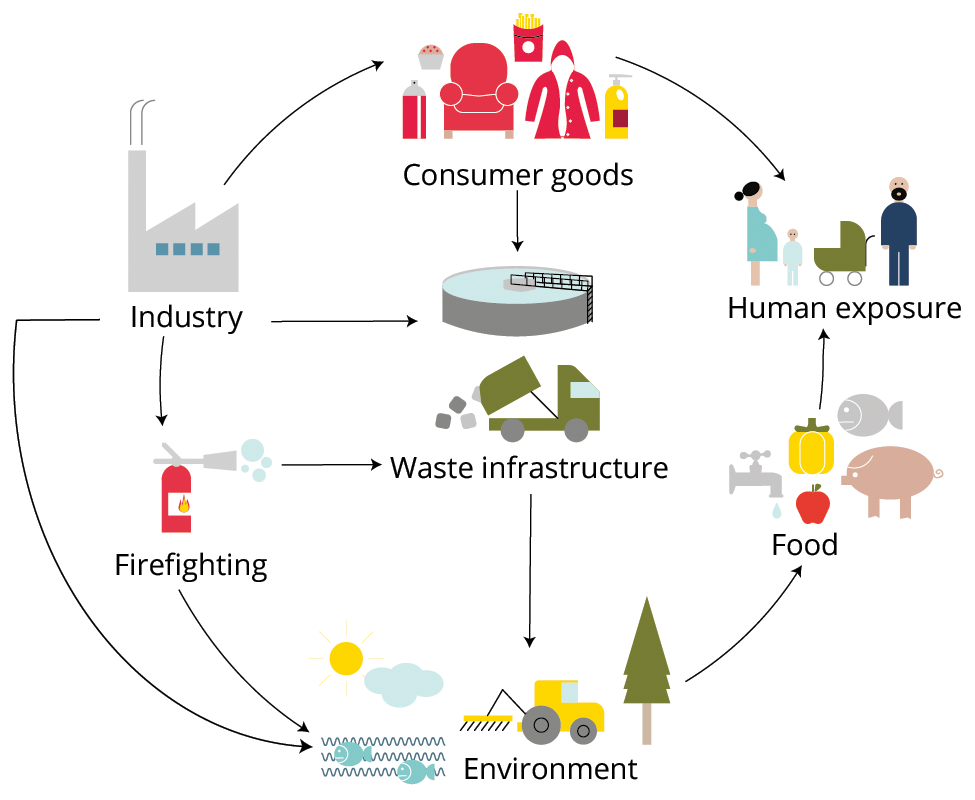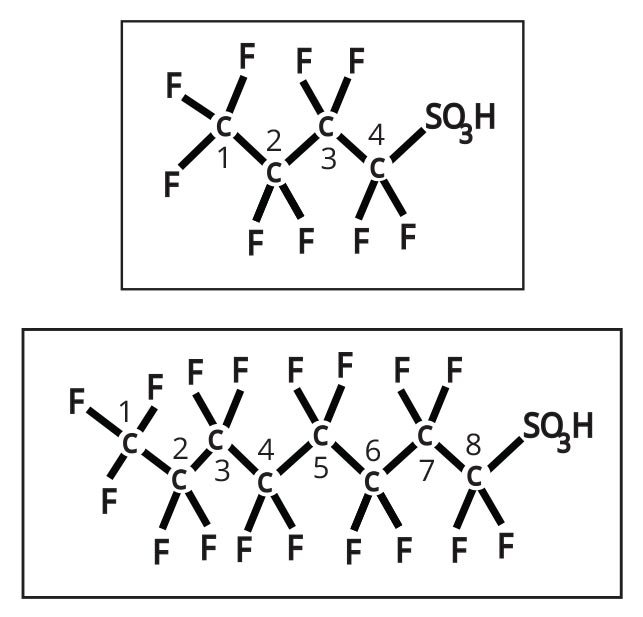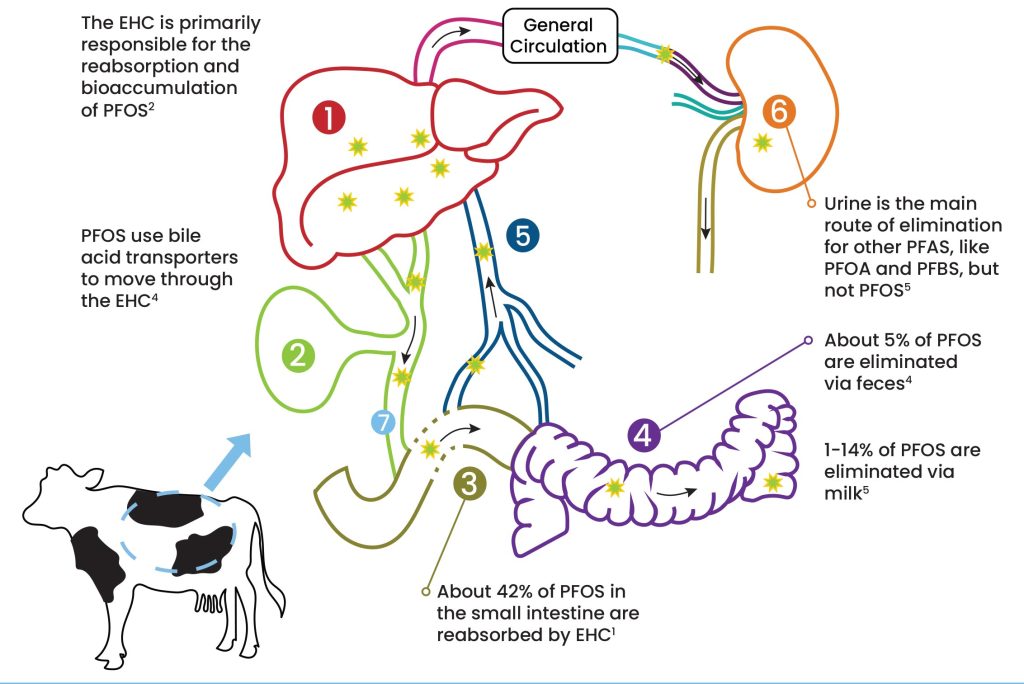PFAS and Dairy Animals
Authors: Ana Jimenez, Glenda Pereira and Juan Romero
Per-and polyfluoroalkyl substances (PFAS) are a group of more than 4,000 chemicals composed of carbon and flourine bonds. PFAS have been in use since 1940 and are found in industrial products because of their resistance to grease, oil, water and heat. Exposure to PFAS via food, water and dust can lead to adverse health outcomes in humans.1

industry, consumer goods and firefighting foam (click image for descriptive text on attachment page). – European Environmental Agency via Creative Commons

Dairy animals can be exposed to PFAS if they eat or drink contaminated feed or water.1 Long chain PFAS such as perflourooctane sulfonic acid (PFOS) accumulate in dairy animals because they mostly are not urinated and are re-circulated through the enterohepatic cycle (EHC).2 PFOS is present in milk even after the animal consumes clean feed because it can take 39-106 days for 50% of the accumulated PFOS to clear from blood.5

Heifers
- Enterohepatic circulation (graphic below) facilitates bioaccumulation of PFOS in the animal until first lactation3 ,4
- There is potential for reducing PFOS with pre-partum feeding management
Lactating Animals
- Milk is a major excretion route of PFOS in contaminated cattle because it is rich in proteins 5
- As milk yield increases, PFOS concentration in milk seems to decrease 6
How do PFOS recirculate?
Enterohepatic circulation (EHC) is the movement of bile acids from the liver to the small intestine and acids are an important component in the movement of PFOS in dairy animals.
Legend |
|
|---|---|
| Liver: cleans blood, aids in digestion by secreting bile | |
| Gallbladder: stores bile | |
| Small Intestine: main site of nutrient and water absorption | |
| Large Intestine: primarily forms feces | |
| Portal Vein: carries blood to the liver | |
| Kidney: removes metabolic waste and extra water from blood | |
| Common bile duct | |
| PFOS | |
|
|
|

1 — Ateia M., et al., The overlooked short- and ultrashort-chain poly- and perfluorinated substances: A review (ScienceDirect) from Chemosphere. 2019 Apr;220:866-882 [https://www.sciencedirect.com/science/article/pii/S0045653518325281?via%3Dihub]
2 — Chiang, J. Y. L. (2013), Bile Acid Metabolism and Signaling (Wiley Online Library), In Comprehensive Physiology (Vol. 3, Issue 3, pp. 1191–1212). Wiley. [https://onlinelibrary.wiley.com/doi/10.1002/cphy.c120023]
3 — Death, C., Bell, C., Champness, D., Milne, C., Reichman, S., and Hagen, T. (2021), Per- and polyfluoroalkyl substances (PFAS) in livestock and game species: A review (ScienceDirect), The Science of the Total Environment, 774(144795), 144795. [https://www.sciencedirect.com/science/article/pii/S0048969720383285?via%3Dihub]
4 — Kowalczyk J., et al. 2012, Transfer of Perfluorooctanoic Acid (PFOA) and Perfluorooctane Sulfonate (PFOS) From Contaminated Feed Into Milk and Meat of Sheep: Pilot Study (Springer Link), Arch Environ Contam Toxicol. 63(2):288-98. [https://link.springer.com/article/10.1007/s00244-012-9759-2]
5 — Kowalczyk J., et. al. 2013, Absorption, Distribution, and Milk Secretion of the Perfluoroalkyl Acids PFBS, PFHxS, PFOS, and PFOA by Dairy Cows Fed Naturally Contaminated Feed (ACS Publications), J Agric Food Chem. 61(12):2903-12. [https://pubs.acs.org/doi/10.1021/jf304680j]
6 — van Asselt ED., et al. 2013, Transfer of perfluorooctane sulfonic acid (PFOS) from contaminated feed to dairy milk (ScienceDirect), Food Chemistry 141(2):1489-95. [https://www.sciencedirect.com/science/article/abs/pii/S0308814613004810?via%3Dihub]
7 — Johnson, J. D., Gibson, S. J., and Ober, R. E. (1984), Cholestyramine-enhanced fecal elimination of carbon-14 in rats after administration of ammonium [14C]perfluorooctanoate or potassium [14C]perfluorooctanesulfonate (ScienceDirect), Fundamental and Applied Toxicology: Official Journal of the Society of Toxicology, 4(6), 972–976. [https://www.sciencedirect.com/science/article/abs/pii/0272059084902355?via%3Dihub]
8 — Cao H., et al. 2022., Effect of Enterohepatic Circulation on the Accumulation of Per- and Polyfluoroalkyl Substances: Evidence from Experimental and Computational Studies (ACS Publications), Environ Sci Technol. 56(5):3214-3224. [https://pubs.acs.org/doi/10.1021/acs.est.1c07176]
9 — Grant R. and Kononoff P., Feeding to Maximize Milk Protein and Fat Yields (G1358, University of Nebraska–Lincoln Extension Publications), 2007. [https://extensionpublications.unl.edu/assets/html/g1358/build/g1358.htm]
PFAS and the Maine Food SystemThis page, “PFAS and Dairy Animals,” is a recommended resource relevant to the work that University of Maine Cooperative Extension and other statewide partners are doing in providing Maine’s communities with essential information regarding PFAS. For More Information and Additional PFAS Resources: |
